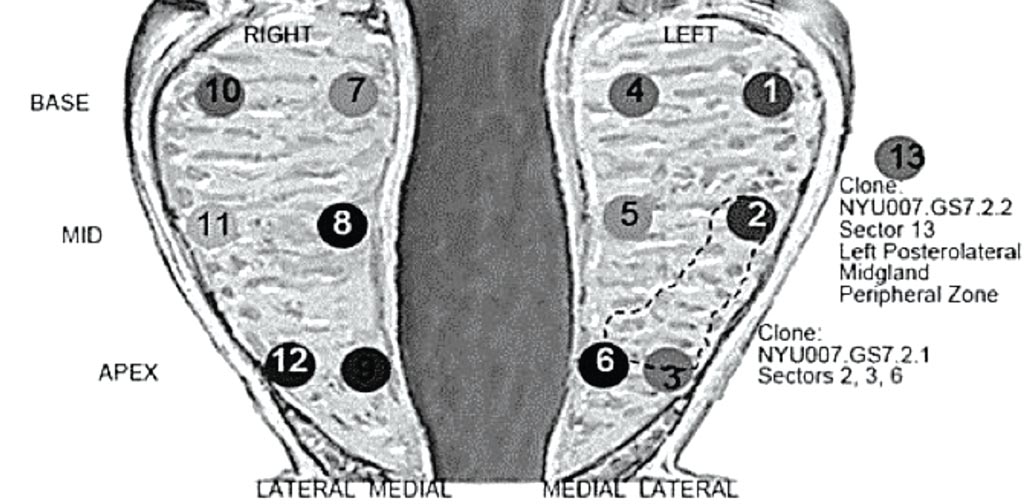Single Cell Genomics Utilized for Evaluation of Prostate Cancer
By LabMedica International staff writers
Posted on 13 Dec 2017
A distinction between indolent and aggressive disease is a major challenge in diagnostics of prostate cancer. Histopathology of tissue biopsies is a standard method used for evaluating cancer risk. Many decades of experience have led to classification of the histological types correlated with clinical outcome.Posted on 13 Dec 2017
A small-scale test of a new analytical method to improve the early detection of potentially lethal prostate cancer has been reported. The utility of single nucleus sequencing (SNS) to aid diagnosis has been explored and based on diagnostic biopsy samples; the method promises to more accurately diagnose men who need surgery from those who do not.

Image: A diagram of the human prostate gland, roughly the size and shape of a walnut, bisected by the urethra. The locations of each of an individual\'s 13 biopsy cores are indicated. Information obtained via single-cell sequencing from cells sampled from each core indicates the likely location of a cancerous tumor (dotted lines encompassing cores 2, 3 and 6) (Photo courtesy of Cold Spring Harbor Laboratory).
A team of scientists collaborating with those at Cold Spring Harbor Laboratory (CSHL, New York, NY, USA) have described a small pilot study on eleven patients. In eight cases, they compared genomic pathology based on SNS to histopathology reports based on standard hematoxylin-eosin (H&E) staining of diagnostic needle core biopsies. They performed SNS on a total of 4,021 nuclei from 122 anatomical locations in 11 patients spanning a broad histological spectrum from benign prostatic epithelium to high grade prostatic intraepithelial neoplasia (HGPIN) and frank carcinoma (within and beyond the prostate) in both early and advanced stage disease.
The team isolated nuclei from frozen core biopsies and biopsy washings, processed and single nuclei were sorted by FACS using the SORP flow cytometer. Single nuclei were deposited into individual wells in a 96-well plate and amplified. Whole-genome amplification (WGA) was performed and after WGA DNA was sonicated using a Covaris focus acoustics system. Multiple libraries were combined into pools ranging from 8-12 libraries to pools of 96 libraries for 76 bp single-read sequencing on single lanes of Illumina’s GAIIx and HiSeq flow cells, respectively.
The team sequences the genomes of several hundred single cells sampled from each patient's biopsy cores. They searched for certain patterns, for the presence of DNA disturbances called copy-number variations (CNVs). Using computational methods to compare CNV patterns, the team looks for cells whose CNV profiles harbor the same irregularities. This is a sign of clonality, as cancerous tumors are composed of clonal cells, genetically aberrant cells that derive from a single wayward ancestor. The parameters all showed good correlation to the measure of prostatic malignancy, the Gleason score, derived from individual prostate biopsy tissue cores.
As the testing method yielded assessments of tumors that more closely matched the verdict of post-surgical pathological analysis (which reveal actual pathology) than the corresponding pre-surgical predictive biopsies, Alexander Krasnitz, PhD, an associate professor and a lead author of the study said, “This is important because treatment decisions in such cases depend on the pre-surgical biopsy, not the surgical specimen. We think single-cell analysis could potentially augment traditional biopsy-core histopathology, significantly improving risk assessment and informing treatment decisions, especially in borderline cases.” The study was published on November 27, 2017, in the journal Cancer Research.
Related Links:
Cold Spring Harbor Laboratory














